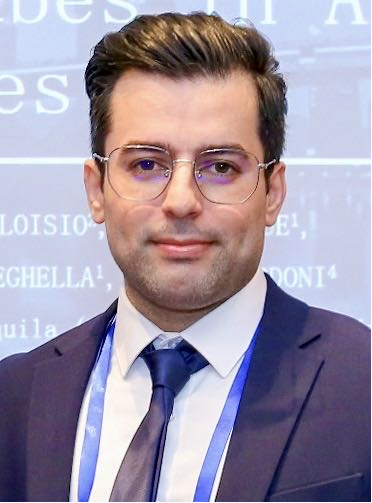

Prof. Danqing Song
South China University of Technology, China
Biography:
Danqing Song is a Professor at South China University of Technology, holding a Ph.D. and serving as the Deputy Director of the Development Strategy and Planning Division. He has been recognized with the "Postdoctoral Innovative Talent Support Program" by the Ministry of Human Resources and Social Affairs of the People's Republic of China, as well as the "Shui Mu Scholars" program of Tsinghua University. Dr. Song has dedicated his career to scientific research on geomechanics related to rock body engineering, particularly in areas such as side slopes, tunnels, and underground caverns. His research focuses on structural dynamics effects of rock bodies, dynamic disasters involving rock bodies, monitoring and early warning systems for geological hazards, prevention and control measures for these hazards, and intelligent construction methods for underground engineering. He has played a key role in several major projects including the Sichuan-Tibet Railway, Three Gorges Dam project, JiuDian Gorge in the upper reaches of Yellow River, HeiFangTai project,and XiangLi Highway among others. Dr. Song's expertise also extends to evaluating deformation stability and implementing prevention measures for landslides,slopes,and deeply buried tunnels within these large-scale projects. His research results have been published in 99 SCI/EI papers (84 SCI papers and 15 EI papers), with 2 selected as ESI Highly Cited Papers in 2020,and 1 selected as Hot Paper in 2023. He has also authored 55 first/corresponding authors' SCI papers(16inTOPjournals) and 12 EI papers, predominantly published in Eng Geol, Landslides, Acta Geotech, Rock Mech Rock Eng and other authoritative journals in the field of engineering geology/geotechnical engineering, etc. The total number of citations is more than 1,200, and the H-index is 20. He has participated in the compilation of 3 industry/group standards, and has filed 36 patents for invention, 6 utility models, and 22 software copyrights.

Assoc. Prof. Ahmad Safuan Bin A Rashid
Universiti Teknologi Malaysia, Malaysia
Biography:
Associate Professor Dr Ahmad Safuan A Rashid obtained his PhD degree in Geotechnical Engineering from The University of Sheffield in 2011 with a Malaysia Higher Education Scholarship. Now, he is an Associate Professor and Deputy Dean of Research, Innovation, and Development for the Faculty of Civil Engineering, Universiti Teknologi Malaysia. He was the Head of the Geotechnical Research Group and is currently the Fellow of Centre of Tropical Geoengineering provides research and consultation work on geological and geotechnical engineering for tropical areas. The major research areas of Associate Professor Ahmad Safuan are soil Mechanics, ground improvement, soil stabilization and slope engineering. He has published 190 refereed journal papers. He has successfully supervised 8 PhD to their completion and currently supervises 12 PhD students.
Speech Title: ENHANCING SLOPE STABILITY PREDICTION USING A MULTIDISCIPLINARY APPROACH AND RADIAL BASIS FUNCTION NEURAL NETWORK: A CASE STUDY ON THE JELAPANG ROCK SLOPE IN PERAK
Abstract: Accurately predicting the stability of complex high rock slopes is crucial to prevent infrastructure damage and potential casualties. Existing studies have primarily relied on linear or log-linear regression models based on laboratory data, limiting their practical application. In this study focused on the Jelapang rock slope in Perak, a multidisciplinary approach combining geological, geotechnical, and remote sensing analyses was employed to consider various rock mass properties and slope geometrical parameters. The Rock Mass Rating (RMR), Slope Mass Rating (SMR), and factor of safety (FOS) were computed for 48 regions of the rock slope. Subsequently, a Radial Basis Function Neural Network (RBFNN) model was utilised to predict the FOS, RMR, and SMR. Three RBFs were developed: RBF-1 for estimating the factor of safety, RBF-2 for rock mass rating, and RBF-3 for slope mass rating. For comparison purposes, the performance of the RBFNN models was compared with Multilayer Perceptron (MLP) models. The results demonstrated that the optimized RBFNN model provided a state-of-the-art technique for accurately predicting and controlling slope stability. Notably, the RBFNN models exhibited remarkable precision, as indicated by root-mean-squared error (RMSE) values of 2.02172e-30 for the training process of RBF-1, 7.58671e-28 for RBF-2, and 2.71129e-27 for RBF-3. Comparison results revealed that the RBF models outperformed the MLPs. Additionally, sensitivity analysis results indicated that Uniaxial Compressive Strength (UCS) had the highest effect on the FOS.

Assoc. Prof. Ahad Javanmardi
Fuzhou University, China
Biography:
Dr. Ahad Javanmardi is an associate professor in the College of Civil Engineering at Fuzhou University, China. Since May 2023, he has been a Visiting Fellow at the Centre for Infrastructure Engineering in the School of Engineering Design and Built Environment (EDBE) at Western Sydney University. He has over ten years of international experience in academia and industry. He obtained his doctorate in Structural Engineering and Materials from the University of Malaya, Malaysia, in 2019. Prior to this, he completed his Master of Engineering, majoring in Civil-Structure, from the University of Technology Malaysia, Malaysia, in 2014. He has been awarded several fellowships and grants including the China Postdoctoral Science Foundation Fellowship and University Malaya Postgraduate Research Fund. His research expertise encompasses interdisciplinary and multidisciplinary areas, including Structural Engineering, Soil-Structure Interaction, Bridge Engineering, Structural Dynamics, Structural Control Systems, Strengthening, Structural Health Monitoring, Smart and Resilient Cities, and Digital Twin. He serves as an editor for several international SCI journals, including PLOS ONE, Buildings, Advances in Civil Engineering, Frontiers in Built Environment, and Frontiers in Sustainable Cities. Additionally, he was an organizing committee member of the IABSE 2018 Spring Conference and a scientific committee member of several well-known international conferences. He has published over 42 peer-reviewed articles, and two book chapters, and holds two patents. He has also delivered speeches at several international conferences and taught online courses.
Speech Title: Recent Developments In Soil-Structure Interaction In Integral Abutment Bridges
Abstract: Integral Abutment Bridges (IABs) have gained significant popularity worldwide, being recognized for their resilience and efficiency. Their unique design philosophy and structural characteristics, which seamlessly integrate abutments and superstructures, minimize the need for expansion joints, thereby reducing vulnerability to wear and deterioration. This simplicity not only enhances structural robustness but also facilitates cost-effective construction and maintenance throughout their lifespan. One of the key advantages of IABs is their superior seismic performance, which is attributed to the continuous connection between abutments and the superstructure. This design mitigates the risk of joint failure during seismic events, ensuring the integrity of the bridge. The reduced number of components and the efficient load transfer mechanism contribute to a more resilient and durable bridge system. Their widespread adoption across North America, Europe, and Asia reflects their appeal to road and railway agencies globally. The mechanical behavior of IABs is significantly governed by the interaction between the backfill soil, pile foundation, and abutment, which strongly influences their response during earthquakes. Designing IABs poses challenges, particularly in managing displacement due to shrinkage, creep, thermal effects, and soil-structure interaction. These issues require careful consideration to prevent damage during the bridge’s service life and seismic events. This keynote speech discusses the recent advancements in soil-structure interaction for IABs, highlighting how these innovations enhance the resilience and sustainability of these bridges in diverse environments.